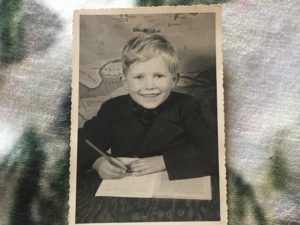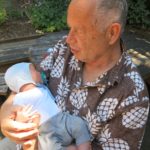 Cousin Ursula sent this photograph along with a (long) story of how she came by it. On the reverse, in a seven-year old’s wiggly script, the name of the school and the year “1950”. I was taken aback, seeing a child I recognized as “me”. Is that how people saw him then? How did those innocent eyes perceive the world on that day?
Cousin Ursula sent this photograph along with a (long) story of how she came by it. On the reverse, in a seven-year old’s wiggly script, the name of the school and the year “1950”. I was taken aback, seeing a child I recognized as “me”. Is that how people saw him then? How did those innocent eyes perceive the world on that day?
French literary theorist Roland Barthes speaks of punctum in photographs as “the element which arises from the scene, shoots out of it like an arrow, and pierces me. … It pricks, wounds, bruises, and lacerates the beholder with its testament of what has been.” [1]
Seeing the photo reels me back 72 years: mom dead six years ago, father recovering from war wounds and loss of identity, corporal punishment normal both at home and school, playgrounds consisting of a city in rubble amidst post-war reconstruction, always hungry as basic foodstuffs (flour, fat, sugar, milk) are rationed, same shoes all summer long, same shirt all week, no socks except in the deep of winter.
 Yet there he sits, upright as directed, blond hair careful combed, pretending to write like a grown-up, smiling as if everything’s ok. Look at those tiny hands! Those brown eyes! What does the observer experience right now: fear, sadness, suffering, . . . or pure innocence: lacking in guile or artifice in the 14c meaning. “The child is the father of the man” writes William Wordsworth in his 1802 poem, “My Heart Leaps Up”.
Yet there he sits, upright as directed, blond hair careful combed, pretending to write like a grown-up, smiling as if everything’s ok. Look at those tiny hands! Those brown eyes! What does the observer experience right now: fear, sadness, suffering, . . . or pure innocence: lacking in guile or artifice in the 14c meaning. “The child is the father of the man” writes William Wordsworth in his 1802 poem, “My Heart Leaps Up”.
To be clear, all you’re looking at is an old photograph, a momentary glimpse staged and frozen in time. The rest is ‘the story we make up’, a projection of stirred-up hurt rooted deep in the heart, an illusionary way markers of a path long obscured by dust. What’s going on for you, right now, dear observer? “Photographs have the potential to […] evoke painful and inaccessible memories which can then be reassembled and given new meaning in the ‘here and now’. [2]
♥
You who let yourselves feel: enter the breathing
That is more than your own.
Let it brush your cheeks
As it divides and rejoins behind you.
Rainer Maria Rilke (1875-1926) [3]
[1] Roland Gérard Barthes (1915-1980). Link. [2] Saita, E. & Tramontano, M. (2018). Navigating the complexity of the therapeutic and clinical use of photography in psychosocial settings: a review of the literature. Research in psychotherapy. 21(1), 293. Full text. [3] Rainer Maria Rilke (1906/2005). In praise of mortality: Selections from Rilke’s “Duino Elegies and Sonnets”. Translated by Anita Barrows & Joanna Macy.

Omg! So great to see you on this photo. I just want to give you a hug!
Hugs to you, Peter. This piece touched me deeply.
Sending early birthday love to the beautiful boy and man!
That is lovely, Peter. Thank you.
[in response to the seeing the photograph]: Wow! That is the Peter I know! Love, H.
Beautiful post, Daishin. It speaks of your essence.
Love to you, dear one.